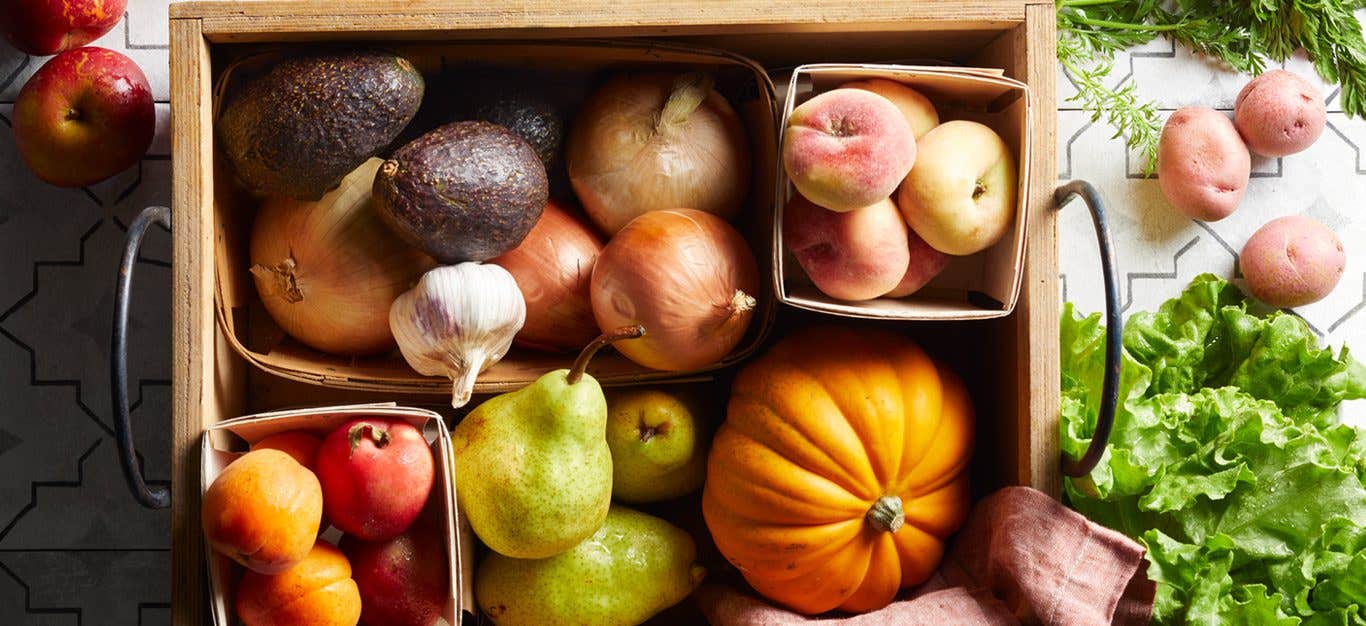When it comes to flavor, homemade broth wins out every time over store-bought and costs about a quarter of what you’d pay in a supermarket. Plus, it’s so easy to make! From full-out recipes to freestyle whatever-is-in-the-fridge combos, there’s a broth technique for every type of cook. Read on for everything you need to know to make your own vegetable broth from scratch.
A note about broth vs. stock: The terms broth and stock tend to be used interchangeably, just as the two liquids can be used interchangeably in recipes. (According to its culinary definition, “stock” is made with bones, but that’s a distinction few people make anymore.)
Basic Vegetable Broth
1 hour | Makes 4 cups
This basic broth recipe has it all: carrots for sweetness and body; celery, onions, and garlic for robust flavor; and a touch of tomato paste for tangy umami. The herbs and garlic round out the other ingredients for a broth that’s tasty all on its own.
- 2 large carrots, peeled and cut into chunks
- 2 celery stalks with leaves, cut into chunks
- 1 medium yellow onion, cut into eighths
- 3 cloves garlic, crushed
- 1 tsp. no-salt-added tomato paste
- 1 bay leaf
- 5 whole peppercorns
- 2 sprigs fresh parsley, or ½ tsp. dried parsley (optional)
- 2 sprigs fresh thyme, or ½ tsp. dried thyme (optional)
- Combine all ingredients in a medium saucepan with 5 cups water. Cover. Bring to boiling; reduce heat. Simmer 45 minutes. (If using a multicooker, combine all ingredients with 5 cups water. Cook on high 15 minutes.)
- Strain broth, pressing vegetables to release all the liquid; discard solids. Store in an airtight container up to 3 days in the refrigerator or up to 6 months in the freezer.
6 Tasty Variations
One of the best things about making your own broth is being able to customize it for a specific recipe. Here are five options that can be prepared by making a few changes to the basic recipe above.
Mushroom: Replace the carrots with 8 oz. (2½ cups) quartered cremini or button mushrooms.
Vegan Chicken: Add 1 sprig each fresh sage, marjoram, and rosemary (or ½ tsp. each dried) to mimic poultry seasoning and give the broth a chicken-y flavor.
French-Style: Swap out the onion for a large leek (white and green parts), replace 1 large carrot with a turnip, and double the thyme.
Mediterranean: Replace 1 celery stalk with 2 fennel stalks, double the tomato paste, and add 2 sprigs fresh oregano (or ½ tsp. dried).
Asian: Omit the tomato paste and bay leaf. Add 2 scallions, 3 coins fresh ginger, 1 extra garlic clove, and 4 sprigs fresh cilantro.
Freestyle Vegetable Broth
Missing some ingredients called for in our Basic Vegetable Broth recipe? No problem. You can whip up vegetable broth using whatever veggies you have on hand, and it’s a wonderful way to use up the leftover or wilting veggies in your fridge. While a freestyle broth may not always have the savory balance of a recipe, it will still boost the flavors of whatever you cook with it. Here’s a basic template, which will yield about 4 cups of broth, followed by some dos and don’ts when it comes to ingredient selection.
- Place 3 cups chopped vegetables (see below for suggestions) in a large saucepan with 5 cups water.
- Cover, and simmer 45 minutes, or until the veggies have softened and released their flavors. Strain the liquid, and discard the vegetables.
- Store in an airtight container in the refrigerator 3 days or in the freezer up to 6 months.
Veggies to Use
- Alliums (onions, leeks, shallots, garlic),
- Stalky veggies (celery, fennel)
- Root vegetables (carrots, parsnips, potatoes). These are veggie broth foundations.
- Asparagus
- Peas
- Corn
- Mushrooms
- Lentils can also be used to add more robust flavor, as Chef Del Sroufe does with his vegetable stock recipe.
- Herbs (dried or fresh)
Veggies Not to Use
- Cruciferous vegetables (broccoli, Brussels sprouts, cabbage, cauliflower, kale, etc.). These have strong flavors that can overpower vegetable broths and make them bitter.
- Turnips and rutabaga (also members of the cruciferous family) should be used sparingly, as these can also make broths bitter.
- Starchy, mushy vegetables such as sweet potatoes and winter squash. These can discolor broth and make it cloudy.
The Scrap Method
The bits and ends of vegetables that don’t make it into a recipe are all packed with flavor. Here’s how to repurpose them into batches of vegetable broth.
- Save those scraps. Collect the peels, fronds, stems and ends during vegetable prep. (Wash all vegetables well beforehand.) Onion peels, garlic skins, and herb stems can all go in as well, along with any wilted or limp vegetables from the fridge. Omit scraps from cabbage-y veggies (aka cruciferous vegetables), but feel free to add squash and potato skins to the mix. Even scraps from veggies you usually eat raw, like lettuce or cucumber, can add body to a scrap broth.
- Store scraps in a broth box. Designate a 6- to 8-cup lidded container as a “broth box,” where you can store your scraps in the freezer. Add to the scrap stash each time you have vegetable parings.
- Get cooking. Once your broth box is full, rinse and drain the collected vegetable scraps to remove any residual grit. Place them in a large pot and cover with ½ inch water. Simmer 45 minutes; then strain and discard the solids, and…voilà! Homemade vegetable broth!
How to Freeze It
Freeze homemade vegetable broth in 1-quart containers for use in soups and stews, or in ice cube trays (1 ice cube = 2 Tbsp.) for oil-free sautés, sauces, and stir-fries. Any leftover broth can be refrozen.
Using Vegetable Broth in Place of Oil (or Water)
One of the foundational techniques in oil-free cooking is the water-sauté, where you skip the oil and sauté vegetables in water or broth, which is added a tablespoon or two at a time. Vegetable broth not only prevents the vegetables from sticking to the pan but also it enhances the flavors of the final dish. Broth can be used to add flavor when you brown and roast vegetables, too.
For more guidance in healthy cooking, check out Forks Meal Planner, FOK’s easy weekly meal-planning tool to keep you on a plant-based path. To learn more about a whole-food, plant-based diet, visit our Plant-Based Primer.

Related News
Get Our Best Price On The Forks Meal Planner

Forks Meal Planner takes the guess work out of making nutritious meals the whole family will enjoy.
Master Plant-Based Cooking!

Our new course features over 100 lessons, 50+ recipes, downloadable guides, and more!



